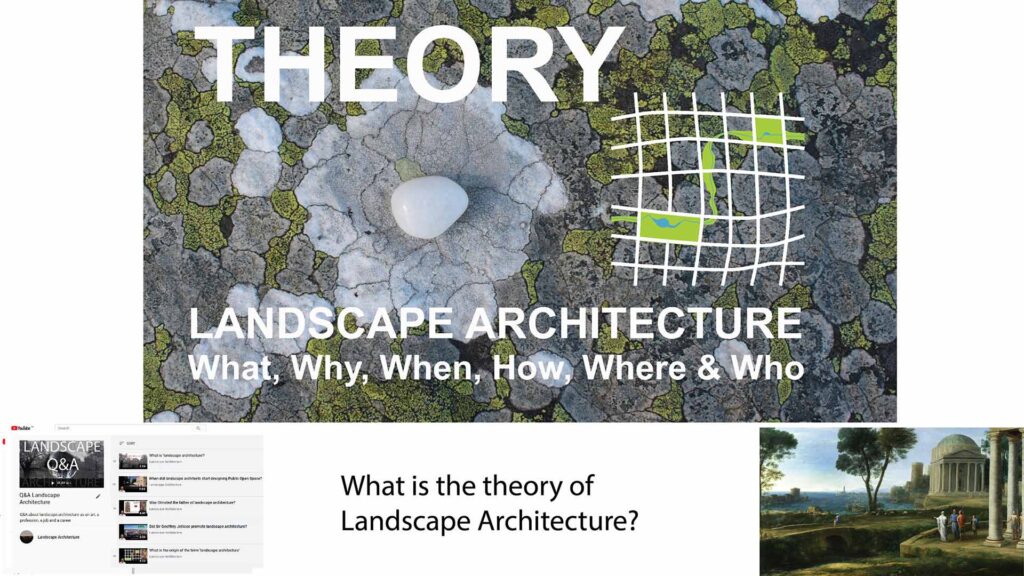What is landscape theory? Q&A

Question What is landscape theory?
Short answer: It is the theory of how to make good outdoor space – and this involves giving further answers to questions about the What, Why, When, How, Where, and Who of landscape architecture – which I did in a 2017 Kindle eBook.
Longer answer: My conception is that the landscape profession has one aim, three objectives and five sets of techniques. You could call it a 1-3-5 profession
• the primary aim is to create a good public realm. Using Jellicoe’s term, we can call it a ‘Collective Landscape’. Or, remembering Claude Lorrain and John Claudius Loudon, you can call it a ‘Claudian’ aim.
• the three objectives are to create places which are useful, beautiful and well-made. These objectives can be summarised as ‘Vitruvian’ and there is much to be said for using Vitruvius’ Latin vocabulary: utilitas, venustas and firmitas. I find the customary English translations misleading. They’re Commodity, Delight and Firmness.
• the five compositional elements of landscape architecture, are land, water, vegetation, buildings and pavings.
The various design professions are both related and distinct, with some close together and others far apart. Like urban design and garden design, they draw on individual aptitudes, educational programmes and bodies of theory. Some architects are good at interior design, others at planning and others, like Alvar Aalto and Zaha Hadid, at furniture design. But it does not follow that ‘architecture’ is a single discipline or that the title deserves legal protection. Nor are urban design and garden design the same thing, though both are more like drawing on the park of a tree than on a sheet of white paper or a computer screen. As an art of composition, urban design can learn from garden design, with landscape architecture as a mother of both.
In its first century, after 1862, when landscape architecture was growing into an organised profession, practitioners wanted to distinguish themselves from garden designers and to become more involved with public projects.
- Frederick Law Olmsted began his professional career with a public project (Central Park) and undertook some garden design later in his career.
- Thomas Mawson, who became first president of the UK’s Institute of Landscape Architects, wrote separate books on Garden Making and on Civic Art. He saw both subjects as part of landscape architecture but by treating them separately he widened the gulf between the new profession and its ancient origins.
- Patrick Geddes, a leading planner, wrote of ‘City improvers, like the gardeners from whom they develop’ – and I’m sorry that the link between cities and gardens, as design activities, has weakened.
Gardens remain excellent places in which to develop spatial concepts and history has many examples of urban design ideas which derive from garden design ideas. Here are some of them
Amarna, in Ancient Egypt, was as much a garden plan as it was a town plan. Beijing was based on the traditional planning of China’s royal estates. They integrated palaces with gardens, parks, rivers and mountains. Isfahan was based on the classical planning of Persian gardens, dating from a thousand years before the birth of Islam. Baroque Rome was planned on the model of Sixtus V’s villa garden, in Montalto. Georgian London’s parks, squares and streets were based on Renaissance and Neoclassical garden plans, as was Edinburgh’s New Town. Nineteenth century Paris, and Washington DC, were based on Baroque garden plans with focal points and radial avenues. The Modernist cities of the 20th century, most regrettably, were not based on spatial ideas and had not been tested at the scale of landscape and garden design. So they’re dead dull.
